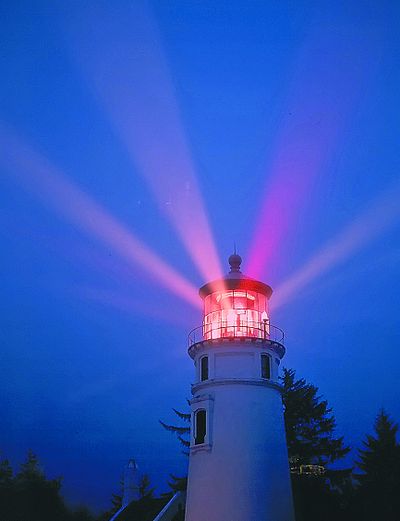Lighthouse may turn off guiding light beams
Coast Guard mulls whether mariners still rely on them

WINCHESTER BAY, Ore. – Since 1894, two white beams of light followed by a red one have pierced the darkness from the Umpqua River Lighthouse at Winchester Bay.
The distinctive flashes let boat and ship captains know that land is near and help them navigate safely along the Pacific Ocean, the mouth of the Umpqua River and Winchester Bay.
The historic Fresnel first-order lens that concentrates the light and allows it to be seen 20 miles out to sea could soon be extinguished or replaced by a more modern light that wouldn’t be part of the stucco lighthouse.
The U.S. Coast Guard, the owner of the lighthouse, is evaluating whether the light is still needed for navigation. If not, the two-ton first-order lens and its 616 colored and clear glass panels that were cut by hand in Paris could be removed and placed in a museum.
County officials and lighthouse lovers would hate to see that happen.
“It has a historic presence. It’s an identifiable icon for Douglas County and the Oregon Coast,” Douglas County Commissioner Joe Laurance said.
Laurance and other county officials would prefer that the light, which runs continuously, remain in full operation. It not only provides safe passage for mariners but is a popular tourist draw, said Gardner Chappell, director of the Douglas County Museum.
“It’s special in a number of ways,” Chappell said.
More than 15,000 visitors a year tour inside the lighthouse, which except for the light itself is maintained by the county, Chappell said. Countless others drive by or park in an adjoining parking lot that overlooks the lighthouse, the dunes and the Pacific Ocean. They also visit the nearby lighthouse museum, housed in the former Coast Guard barracks maintained by the Douglas County Museum.
The Umpqua River Lighthouse replaced an earlier light that was constructed on the north spit of the Umpqua River in 1857, two years before Oregon became a state. That lighthouse only lasted a few years, however, before toppling into the river. The lens, however, was saved.
The new lighthouse was constructed on a 165-foot-high sandy bluff that overlooks both the mouth of the Umpqua River, Winchester Bay and the Pacific Ocean. It was built using the same plans as its more famous cousin, the Heceta Head Lighthouse north of Florence.
The lens for the lighthouse was crafted in Paris by Barbier & Cie. It stands nearly 10 feet tall, with a diameter of almost five feet.
Originally, the lamp was lit one hour before sunset and remained burning until one hour after sunrise. Curtains were drawn around the lantern room to prevent the sun from sending beams of light in various directions.
The light was automated in the 1960s and currently shines day and night.
The Coast Guard sent out surveys to boaters who use the Umpqua River Waterway. They were asked about their use of different types of navigational aids, including the lighthouse, electronic charts, GPS systems, shore lights, buoys and compasses.
“There were some people who felt a light wasn’t needed for navigation,” Park said during a phone interview from his office in Seattle. “Others felt it was needed.”
A report with the Coast Guard’s recommendations is expected to be issued next month.
Joe Coyne, a Winchester Bay resident who serves on the Umpqua River Lighthouse & Museum’s advisory committee, said the lighthouse and its lamp are an important draw for the area. It just wouldn’t be the same without the beams of red and white light illuminating the trees surrounding the lighthouse and stretching out to sea, he said.
“It would mean part of the magic of the lighthouse would be gone,” Coyne said.